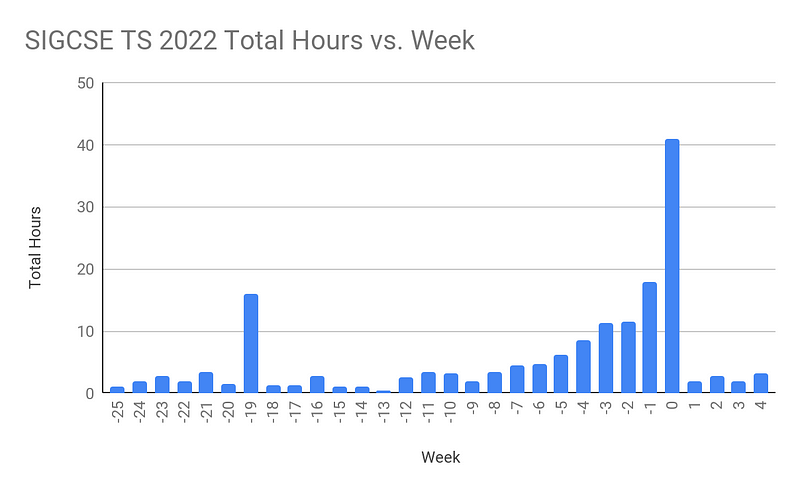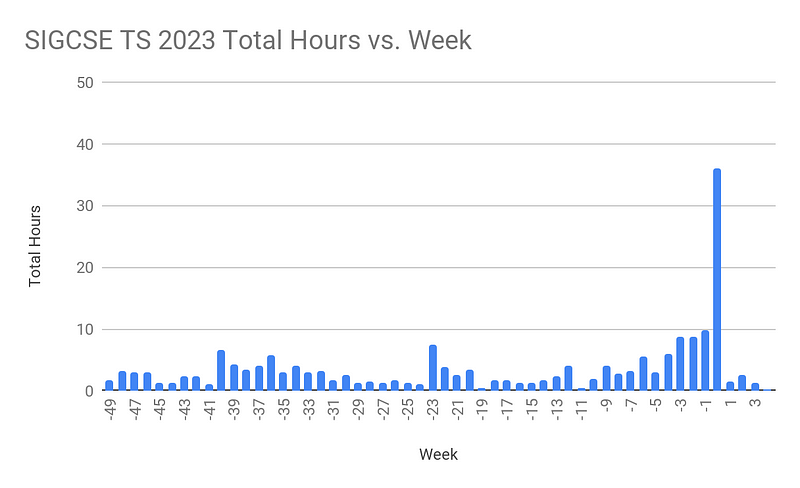Hybrid Chair for SIGCSE TS 2023 (Round 2)
Time for a reflection on being the Hybrid Experience chair for SIGCSE TS 2023, a.k.a. round 2! This year was so much more manageable in terms of time commitment. I also helped introduce new processes and aspects to the symposium. In this post, I will start with the new processes and structures and then talk about the time commitment since the latter section references things from the former section.
[Also posted on medium.]
New Processes and Structures
The most significant difference is rather than being a committee of one, I was part of a committee of four! Dela Yazdansepas was my junior Hybrid Experience Co-Chair. Jacqueline Smith was the Authors’ Corner chair and Jessica Yauney was the Online Experience chair. Spreading both the workload and the mental load was extremely helpful and reduced so much of the stress.
In addition, three other things. The first was to create a Trello Workspace for the committee. You all know I love my Trello boards (class Trello blog post, personal Trello blog post, Trello board of podcasts). My argument to the organizing and program chairs for why we should use it was similar to why I use Trello for my classes. And I think it helped a lot to keep us on the same page, communicate who was doing what, and when things were done. I also know that the 2024 chairs made their own workspace well before the symposium and started to populate it to help them plan 2024. So I think that’s a good sign that they appreciated it.
The second thing I advocated for was creating the Universal Design Committee. Maureen Doyle (senior organizing chair) also cared about improving accessibility. So I suggested taking the accessibility chair role and reimagining it to focus on universal design. This year’s focus was more on accessibility than anything else. But I hope the committee will expand its mission for the symposium over time.
Finally, I got all seven chairs to use a shared email address and inbox. Adam Blank (web and data team) set us up with FreeScout. The goal was to reduce the inefficiencies we all faced in 2022, where multiple chairs responded to the same email with basically the same message. In addition, there was a lot less forwarding of email threads, and if we moved to Slack for a discussion, it was straightforward to just link to the email thread so everyone was on the same page.
Time Commitment
So how much time did this all take? Well, time for some quantitative self. I track my work time by the 15-minute increment. Let’s start with a side-by-side of the time commitment for 2022 versus 2023.


TS 2022 starts 25 weeks before the symposium, when I joined the committee, and extends 4 weeks after TS 2022 ended as we wrapped things up. Though, there is an overlap between the two years during that time. TS 2023 starts right after and also ends 4 weeks after. Notice that the y-axis is the same height, but TS 2023 spans an entire 52 weeks while TS 2022 does not, so some comparisons might be a little tricky.
There are a few things to notice when comparing the graphs. First, there is no spike around week -19 for TS 2023 because I did not go on the site visit. I recommended that someone from the Universal Design Committee go instead of me. And I provided that member with suggested things I’d like them to look at for me. I did not have the time for such a trip, and the Hybrid Committee’s interest in what was on site was a subset of things the Universal Design Committee would be looking for. So I believed that committee would take care of things.
Unsurprisingly, I worked more for TS 2023 than TS 2022. However, the experience was so much different. I worked 167 hours for TS 2022 and 195 hours for TS 2023. This difference is not surprising because I was involved with TS 2023 right from the start, and we spent the summer figuring out the platform, in-person versus online “rules” for the different tracks, etc. However, during the same timespan as TS 2022, starting at week -25, I worked 128.75 hours for TS 2023. That is much less than 167 hours, and the difference is not accounted for by just not going on the site visit. And this change is almost all because hybrid was a committee of four than just me alone. Dela was also fantastic at helping me, especially during the symposium itself. She and I seamlessly tossed things back and forth. Moreover, we worked as an excellent team where whoever saw it first took responsibility to either do a task or ensure it got done. This was a massive relief because I had several events to attend (2 panels, 1 special session, and my Ph.D. student’s research talk). I had no worries that something would happen while I focused on them.
Going Forward
Now that my two-year service is over, what am I doing next? Well, the symposium is not quite done with me. I’m sticking around as Emeritus Hybrid Experience Chair. Most of us deemed it wise since the odds are good that there are things that are only in my head. Hopefully, most of what I’ll do is answer questions, tell Dela things I forgot to mention, and provide my thoughts and ideas. My goal is to be hands-off as much as possible since the only way hybrid will survive without me is if it actually survives without me. But it doesn’t hurt to stick around as a safety net the first year I’m away.
Conclusion
Now that I’ve done this twice, I have many thoughts on how the symposium should move forward with hybrid. For starters, I think, we need to shift away from copying what happens in the in-person experience onto the online experience. Instead, we need to innovate. How to innovate is the question. My first thought is we need more information. Who are we designing for? Especially who are the online-only attendees or attendees that will utilize the hybrid aspects of the symposium? What are the design goals of the symposium for those attendees or attendees in general? Starting with the goal in mind, we can start thinking through what we should stop doing (like I think we can skip requiring pre-recorded videos for accepted submissions), change, and innovate. I’d love to see ways to help attendees get the “hallway track” experience that so many people love about the symposium.
But that is a blog post for another day. If you would like to hear my thoughts on that, please let me know via a comment or email.
Comments
Post a Comment